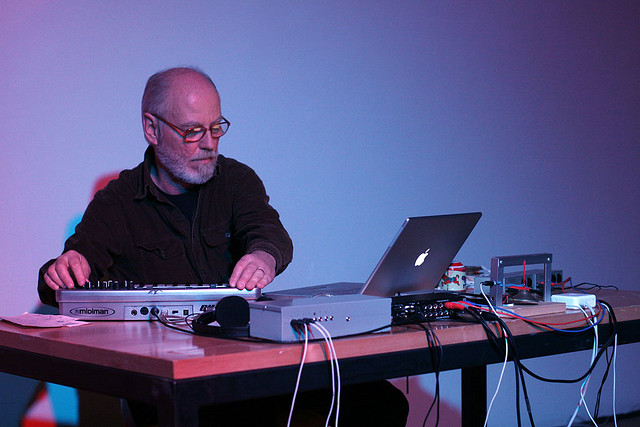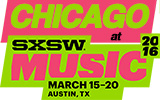| « Preview: Bill Callahan @ Garfield Park Conservatory, 5/6 | Review: Palma Violets & Guards @ Schubas, 5/1 » |
Concert Thu May 02 2013
Music on 1K of RAM a Day: John Bischoff's Computer Constellations at Graham Foundation / Lampo, 5/4

This Saturday, Lampo welcomes John Bischoff, a composer of computer-generated (and manipulated) music and founder of pioneering computer-based music groups The League of Automatic Music Composers and The Hub, at the Graham Foundation's Madlener House (4 W. Burton Pl., Chicago) at 8 p.m. Admission is FREE with RSVP. Do so here.
These days a lot of electronic music could realistically be called "computer music," in that way your parents might have called anything from Tangerine Dream to Devo. Because nearly all music today is made with some sort of computer interface or another (even if just in the mixing and mastering stage), the idea of "music made with computers" seems less radical than it did in, say, 1977. At that time, if you really wanted electronic technology harnessed to what you'd call a "computer," you probably had to have access to an academic computer lab or a multi-million-dollar assemblage of devices, whether it was the MIT electronics lab or the TONTO system (as used by Stevie Wonder and others). But even then, what you were really talking about was an analogue synthesizer system using a computer interface as a sequencer. Computers were not the ubiquitous devices they are now. There wasn't that sense that everybody had a right to his or her own computer. In fact, most people probably thought the "computer lifestyle" wasn't for them, or wouldn't be until we all lived in the future.
To make "computer music" in 1977, it meant you had to deal with extreme primitivism. The KIM-1 computer, created in 1976 by MOS Technology and later bought by the Commodore corporation (the folks who gave you the VIC-20 and the Commodore 64), was one of the first affordable and mass-marketed home computer system. Though still advertised mostly in specialty or science magazines, the computer's price (approximately $200) and expandability made it a quick hit amongst adventurous technophiles. Among its useful features was the ability to create simple music programs and sequences, sounds that, even by today's 8-bit nostalgia standards sound like the equivalent of rubbing two circuit boards together in a cave for warmth. Not anyone's idea of "beautiful music" at the time, but if you were Jim Horton and John Bischoff, you saw possibilities.
The League of Automatic Music Composers featured its primary performers (Bischoff, Horton, Tim Perkis, David Behrman, and others) working with KIM-1 computers, just a circuit board and some cobbled-together parts (including a cassette storage drive and a hexadecimal keypad to program in the 6502 assembly language) to push the devices to their limits - not a hard thing to do in a machine with 1K of RAM. Though connected with Mills College and given access to their electronic music facilities, Bischoff, Horton, and Perkis were excited about the possibilities of computer music on a smaller, more personal scale. The recordings under the League name sound like an army of people collectively losing at "Jumpman" or other early computer games, as crunching, buzzing clouds of ugly noise smother strange, abstract musical scales and non-linear sound constructions. The ability to link multiple machines gave unprecedented opportunity for collaboration between several musical minds, as each person brought in their own pre-programmed "songs" and then chained them together, adding new material and modifying material being played during the performance.
Check out this later-period League video for proof:
Though admittedly crude by today's standards, you can feel the excitement of the participants as they dig into this fragile technology, stretching the canvas of what can be done with these new devices.
The League was through by 1983 (brought on in part by Jim Horton's arthritis, which made performing a painful prospect), and by 1986, goaded on by some of the wild, unfettered electronic music being heard on underground and college radio stations at the time, Perkis and Bischoff co-founded The Hub, another computer-based collective that used the advances in computer linking and collaborative technology to create a system in which individual performers could collaboratively share and pass source material back and forth during the performance, constantly altering the possibility of their individual pieces. Growing to six members, The Hub continued operations from the late '80s into the '90s, and even released the occasional album (unlike the League of Automatic Music Composers, who only saw one recording - a side of a 45 record - recorded during their existence; a retrospective League CD on New World Recordings, and a Memory Stick [!] archive release on Alku compile 13+ additional hours of League material, both audio and video, for the ages). John Zorn's Tzadik label released a 3CD retrospective of The Hub in 2008.
During this time, Bischoff taught computer music at Mills College and through the years has sporadically released music under his own name. The most readily accessible release these days is probably the Aperture CD (released 2003 on the 23Five label), a widely-released (by underground music standards) album of computer-based compositions that involve interactive devices in which the performer can actively disrupt or alter the data streams and processes being initiated. Though sometimes turbulent, the mood on much of Aperture is contemplative, never dribbling into New Age mindlessness, but as tracks like "Piano 7hz" demonstrate, the ideas don't always have to punch you in the throat to be effective.
Though his releases often come with multi-year spaces between them, 2012 brought a bounty of riches: new music stalwarts New World Recordings released Audio Combine, a CD containing five new tracks, while the Important Records cassette sub-label Cassauna released the hyper-limited Field Transfer tape.
I had a chance to ask John about Saturday's performance and his years as a composer, which he was gracious enough to answer en route from California to Chicago.
What drew you to music made with computers in the first place? What did you find appealing about personal computers as music makers at a time when these devices were still primitive in comparison with, say, more conventional analogue synthesizers and sequencers?
A close colleague of mine in the late 1970s — Jim Horton — got me interested in the KIM-1, one of the early microcomputers that came out during that time. Jim was an analog synthesizer player who knew that small computers were coming down the pike and was super enthusiastic about their open architecture and programmability for electronic music when they arrived. I quickly became infected with the same enthusiasm. As you point out, it wasn't the computing power of these small machines that was important — it was the potential for experimenting with any idea of music you could dream up.
Were there major compositional or theoretical differences between the League of Automatic Music Composers and The Hub?
The League's starting point for creating pieces was to bring together individual solos composed by members and play them simultaneously in the group context. A second step in the process involved agreeing on ad-hoc data exchanges between solos, which added points of correlation to the multi-part texture. The Hub, on the other hand, defined pieces by starting with a data exchange protocol specified by one member of the group up front. All members then were on their own in coding a musical realization of the idea. Each "spec" defined the types of interaction between independent parts and therefore provided a core identity for each piece. Both groups worked on balancing the independence of separately composed parts with the coordinating influence of data sharing.
One of the things that still sounds exciting about the League of Automatic Music Composers recordings is the way you were taking computers with relatively constrained technological parameters and pushing them beyond their limits. With the leaps made in computer technology in the intervening decades, is it still possible to push your machines beyond their limits, or are they capable of taking whatever complexity you can throw at them?
An interesting, and challenging, question! The power and complexity of current computing machines is indeed a quantum leap from the machines of the late '70s. Even so, I try to find sonic behaviors in the new machines that are clearly bounded and have a character that comes in part from limitations that I build in. So more powerful machines give us greater sonic resolution, variety, and fidelity — but otherwise the musical challenges are much the same.
After several years of recording silence, you've graced us in 2012 with two new recordings, a CD on New World Recordings and a cassette on Cassauna. Could you tell me a little bit about Audio Combine and Field Transfer?
The five pieces on the Audio Combine CD, and the three different versions of "Field Transfer" on the cassette release, all share a common feature. Each uses an external sound source that is manually activated by the performer and serves as both a sonic component in the piece and as a trigger for a digital audio response in the laptop. Sometimes the external source is an amplified acoustic object, sometimes an analog circuit. All the pieces use similar techniques in analyzing the external sound source — peak detection, spectral analysis, and elapsed time measurement between sonic events. The analysis data is used in real-time to inform the audio response generated in the laptop.
What would you like attendees to know about the works you'll be performing on Saturday?
My chief musical concerns in performance are two: 1. to create a goodly variety and musicality of sounds with the particular external sound source — an analog circuit in the case of all the pieces I will be performing; and 2. to shape the balance between change and stability in the laptop response.















